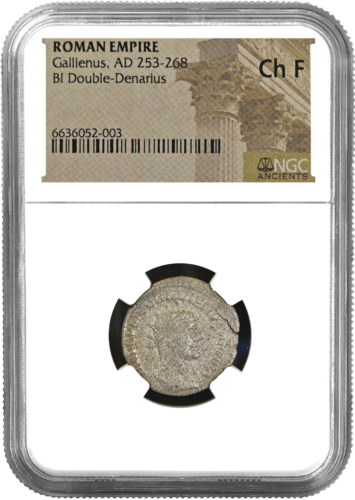


About the coin: The denarius is a small, distinctive and the first silver coin, which was considered the main unit of currency in ancient Rome until the 3rd century. The denarius was first minted in 269 BC (6.8 g of silver), copying the Greek silver didrachm. Although denarii were not minted from the middle of the 3rd century onwards, they were still used as a kind of unit of account in the late Roman Empire. In southern Europe, the word 'denarius' became a generic word for 'money', which passed into Spanish (dinero), Italian (dinaro), Portuguese (dinheiro) and Slovene (denar).
Thousands of years old denarii typically weigh between 3 and 4,5 grams. In imperial times, portraits of emperors were commonly depicted on denarii. The Roman Emperor Gallienus is depicted on the denarii of 253-268. The obverse of the silver coins depicts a glowing, ornate bust of Emperor Gallienus facing to the right. Emperor Gallienus was the son of Emperor Valerian. He made a significant contribution to the history of warfare, fighting against the Goths, Germanic and Sarmatian forces that attacked the empire's borders. He was also successful in fending off waves of barbarian invaders and, after a long period of time, finally defeating Postumus. In addition to these notable achievements, Gallienus was a cruel tyrant with a strangely gentle disposition.
The reverses of the denarii vary accordingly according to the year. The reverses of the denarii minted between 253 and 258 show images of Jupiter with a sceptre, with Emperor Gallienus standing next to him. There are also images of Galien and his father Valerian, and a representation of a sacrifice above the altar. Liberalitas can also be seen in the reverses. This is the personification of Roman generosity, used by the emperors as a propaganda tool. On the coins, Liberalitas is depicted as a woman holding abundance, honesty and generosity in her hands.
Condition of the coin: XF - VF